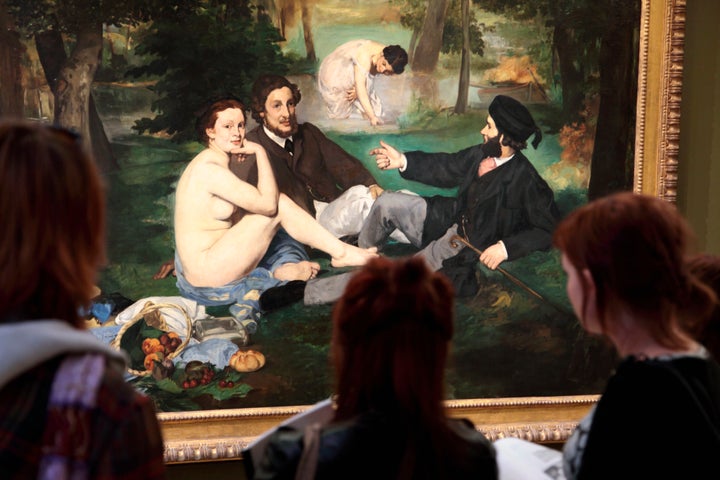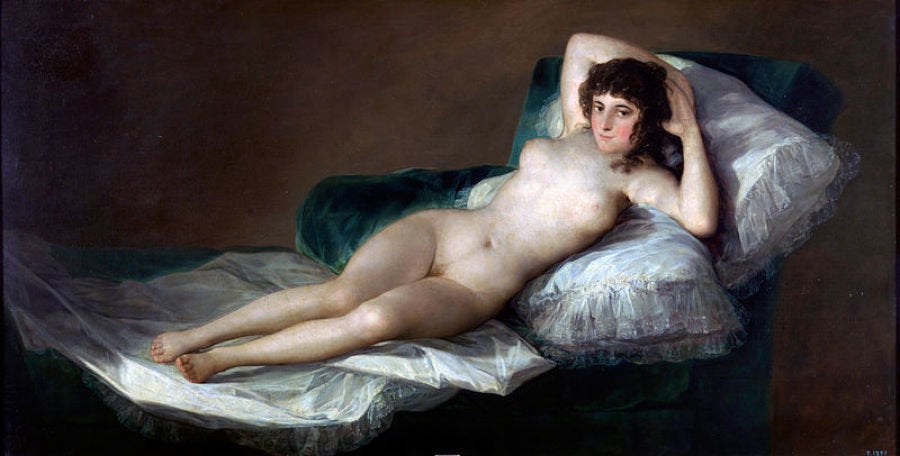
One person gazes into a tranquil painting of water lilies by Claude Monet and can't help but well up with tears. Another, unmoved by Impressionism, stares at a bawdy self-portrait by Cindy Sherman and feels transfixed. Someone else is still bored with both, preoccupied with a bit of three-dimensional chalk art made to look like gummy bears.
You see, we humans are capable of having very, very different tastes in art.
If you took an intro philosophy course in college, you are probably familiar with Immanuel Kant's friendly ol' theory on aesthetics. In short, the 18th-century Prussian writer thought that beauty was not a property of artwork, but rather part of a viewer's emotional response to a particular artwork. So, yeah, beauty is subjective.
But Kant also asserts that just as our idea of beauty -- or, more specifically, our judgment of taste -- is subjective, it's also universal, in so far as anyone can appreciate beauty without needing to find a use for it. At the end of the day, we all have a capacity to be moved by art, of one kind or another. Something will pique our interest, satiate our artsy appetite. It's just -- the chances are that one man's trashy art is another man's masterpiece.
Take it from researchers Edward A. Vessel, G. Gabrielle Starr and Nava Rubin. In a recent study published in the journal Frontiers in Human Neuroscience, the three explored this idea -- that while individual people have strong reactions to very different sets of images and works, the ability and desire to be aesthetically moved by art, music, or literature appears to be universal across human beings.
Curious about this apparent paradox, Vessel et al. decided to take a look inside the brain.
To do so, the team had 16 subjects (11 male, 5 female) lie in an fMRI scanner and view a selection of 109 artworks from the Catalog of Art Museum Images Online database. Looking at each artwork, the subjects were asked to answer the question, “How strongly does this painting move you?” using a scale of one to four. The subjects were told to consider their answers in terms of "gut-level responses" in order to indicate what works they found "powerful, pleasing, or profound." After the scans, the same subjects were placed in front of a computer screen and told to complete a questionnaire that asked them to address the "evaluative and emotional components of their aesthetic experience" for each of the 109 artworks.
Not so surprisingly, at the end of the study, Vessel and the research team found that participants' formulated responses to the art that "moved" them varied greatly in intensity, characterized by everything from joy, awe and pleasure to sadness, disgust and confusion. "On average, each image highly recommended by one observer was given a low recommendation by another," they wrote.
In other words, people had very different tastes.
But in the scans, the levels of brain activation in a person experiencing a "moving" piece of work (a four) were actually quite similar. "The neural systems supporting aesthetic reactions ... are largely conserved from person to person," the trio wrote, "with the most moving artworks leading to a selective activation of central nodes of the DMN (namely, the aMPFC, but also the PCC and HC) thought to support personally relevant mentation."
Jessica Herrington digested this information in SciArt America: "The most moving artworks activated more brain regions known to play a role in computing personally relevant information, as well as evaluating aesthetic and emotional experiences. That is, people were more emotionally ‘moved’ by an artwork when they thought it was relevant to them."
Here in lies the universalness -- and the subjectivity! Our aesthetic experiences are universal, in that the brain areas activated by "moving art" are largely constant across individuals. But these areas are responsible for mediating our subjective and personal experiences. Kant was right, the two interpretations of beauty aren't mutually exclusive!
But pushing aside Kant and the nitty-gritty details of one academic study -- a study that certainly begs for more research to explain why exactly our brains can be moved by things grotesque and gorgeous -- there's one takeaway I'd hope you glean. And it appears bolded twice in this article already.
The likelihood of you and another person sharing the exact same opinions on a group of artworks is as probable as you both having the same stock of personally relevant information hidden inside your mind. More likely than not, you're going to disagree, and that's OK! Science, dear readers, says that's OK. I say that's OK.
So, the next time you stumble across a piece of art, be it a nude photograph or a splashy bit of graffiti or a confounding work of contemporary sculpture, please refrain from exclaiming, "This isn't art!" Not only are you reducing the very subjective act of judging a piece of art to a yes-or-no question, you're ignoring the incredibly complicated system of neurons and cache of personal experiences that inevitably influence your answer.
Try, before uttering the cursed phrase, to ask yourself: "Does this art move me?" And maybe that question alone will inspire you to think more deeply about your subjective and personal relationship to art.
Remember, while one piece of art is not moving you at all, it might be moving someone else, on a neurological level no less. And that's pretty wild.
Also on HuffPost:

